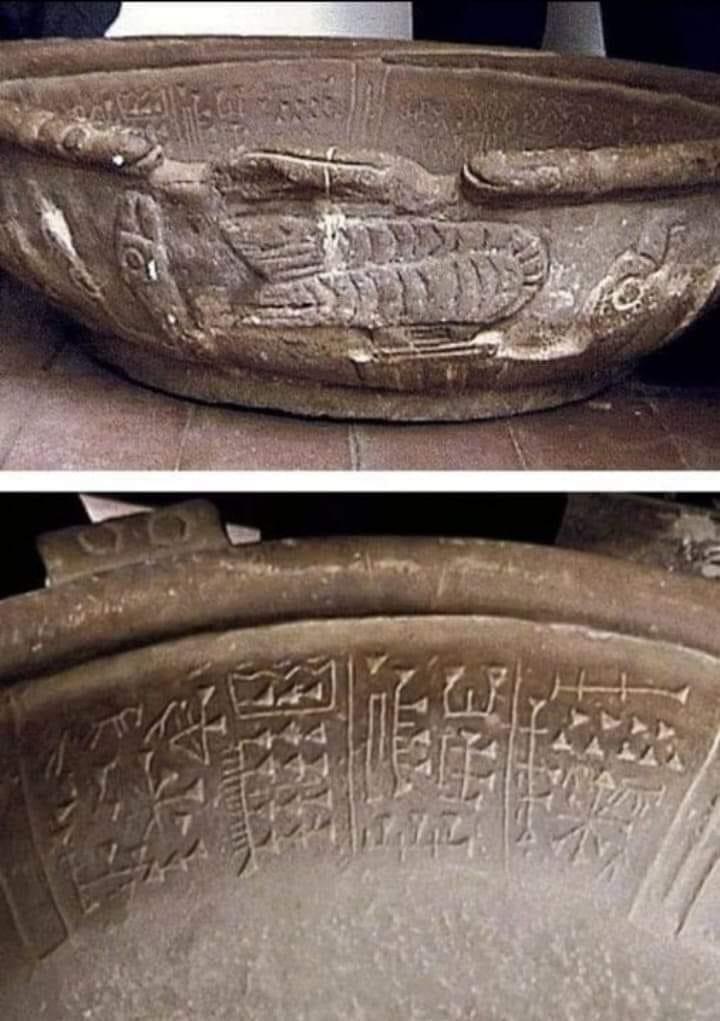In 1950, a Bolivian farmer unknowingly uncovered an artifact that would later spark international debate and challenge mainstream interpretations of ancient human history. While working the land near the shores of Lake Titicaca, he came across what seemed to be a simple stone basin. At the time, unaware of its true significance, he repurposed the object as a pig’s trough. However, this humble item would soon earn global attention from archaeologists, linguists, and historians, becoming the centerpiece of a mystery that crosses continents and centuries.

What initially appeared to be a mundane relic from local indigenous culture turned out to be something much more complex. After years of use on the farm, someone finally took a closer look at the interior of the basin. To the astonishment of observers, the inside surface was covered with engraved markings—symbols that bore a striking resemblance to cuneiform, the writing system used by the ancient Sumerians over 5,000 years ago in Mesopotamia, which corresponds to present-day Iraq. This curious artifact, now famously referred to as the “Fuente Magna,” would become a cornerstone in a growing body of evidence suggesting ancient cultural connections between civilizations thought to be isolated by vast oceans and time.
As news of the engraved basin spread, experts from around the world weighed in on its possible origins and implications. Among the most prominent voices was Dr. Clyde Ahmed Winters, a linguist and scholar known for his work on ancient scripts and African connections to early American civilizations. Alongside him, Bolivian archaeologist Max Portugal Zamora also studied the basin in great detail. Through their research, both concluded that the inscriptions resembled proto-Sumerian writing, with some signs even consistent with early Libyco-Berber and pre-cuneiform scripts. These revelations opened the door to countless questions about ancient transoceanic contact, forgotten trade routes, and the sophistication of early explorers.
What was a vessel marked with Mesopotamian-style script doing buried near Lake Titicaca in South America? How could writing associated with civilizations thousands of miles away and separated by centuries end up in Bolivia? Such questions fueled a wave of theories—some conventional, others more speculative, but all deeply fascinating.
One leading theory proposes that ancient maritime civilizations originating from a sunken landmass known as Sundaland—located in what is now Southeast Asia—might have embarked on transoceanic journeys that led them to the Americas. These early seafarers, potentially capable of navigating vast stretches of the open sea, may have carried items like the Fuente Magna with them as cultural or religious objects. Another hypothesis suggests that the Sumerians themselves were far more advanced in naval technology than previously believed. This school of thought argues that their ships might have reached the Americas long before the commonly accepted narratives of early human migration and exploration.
Regardless of which theory proves most accurate, one thing is certain—the Fuente Magna challenges the established view that ancient cultures evolved independently in isolated regions. Instead, it supports the idea that human civilizations have been in contact across oceans far earlier than most historians have acknowledged. The basin’s discovery invites us to consider the possibility that global interactions, cultural exchange, and the sharing of knowledge were part of humanity’s story long before the modern era.
What makes the Fuente Magna particularly compelling is not just its mysterious engravings, but what it symbolizes: a bridge between distant lands and peoples, and a shared heritage that may have been more interconnected than we once thought. For archaeologists and researchers, the artifact serves as both a puzzle and a portal—a piece of physical evidence that forces us to confront our assumptions and expand our understanding of ancient civilizations.
The implications are vast. If confirmed to be authentic and accurately dated, the Fuente Magna could indicate that civilizations such as the Sumerians, or other advanced groups from Asia or the Middle East, had the means and motivation to travel across oceans. Such a possibility redefines our perception of ancient capabilities, placing early navigators in a new light—not merely as local traders or regional sailors, but as global explorers who ventured far from home in pursuit of connection, knowledge, or spiritual purpose.
Furthermore, the Fuente Magna is a call to remain open to new interpretations of old evidence. History is not a fixed narrative carved in stone but a dynamic, ever-evolving story shaped by fresh discoveries and deeper insights. As technology improves and interdisciplinary studies become more common, our ability to uncover and decode historical mysteries increases. In this context, relics like the Fuente Magna are not just archaeological curiosities—they are active participants in the rewriting of our collective past.
It is important to recognize that many mainstream institutions remain cautious, even skeptical, about the conclusions drawn from the Fuente Magna. Some argue that the inscriptions are coincidental or misinterpreted, and that without more context or related artifacts, it is difficult to verify its origin. Nonetheless, for independent scholars and those passionate about ancient mysteries, the basin remains an intriguing anomaly worth exploring.
Ultimately, the discovery of the Fuente Magna challenges us to think beyond conventional timelines and geographical boundaries. It reminds us that ancient humans were inquisitive, inventive, and likely more interconnected than we’ve been taught. Far from being primitive or static, early civilizations may have been dynamic forces of exploration, migration, and cultural exchange.
As we continue to investigate ancient relics and the secrets they hold, the Fuente Magna stands as a beacon of curiosity—one that lights the way toward a more inclusive and expansive understanding of human history. Its markings, silent yet profound, whisper a story of forgotten journeys and ancient knowledge, daring us to listen more closely and dig a little deeper.





